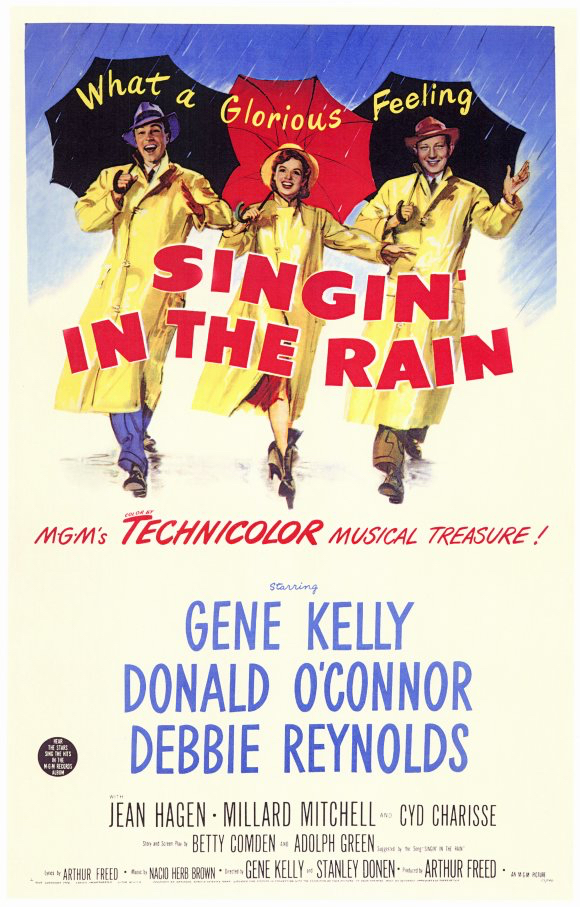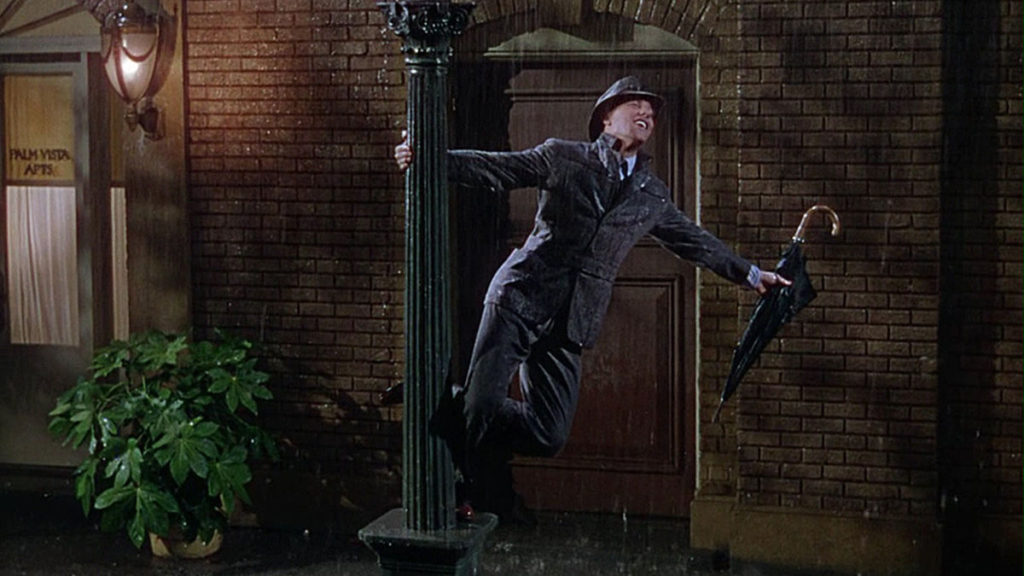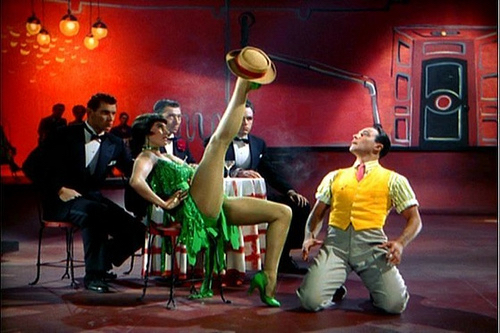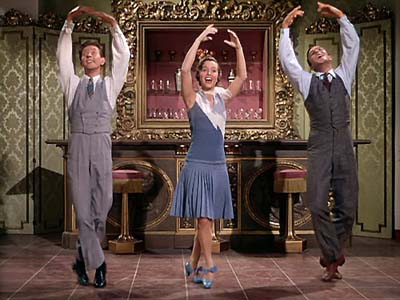Week of June 14 – 20, 2020

My final choice for this category is the film considered by many to be the greatest musical ever made. Maybe it is, maybe it isn’t; there are others which I feel are better. But there is no doubt that Singin’ in the Rain (1952) is one of the happiest films ever made. Interestingly, as much as it is revered today, it was not so beloved at the time, and it was not even nominated for the Best Picture Academy Award that year, which seems unbelievable today. That is due, I think, to the appearance one year before, of An American in Paris, another MGM musical, one which was incredibly popular and won the Academy Award (over such stalwarts as The African Queen, A Streetcar Named Desire and A Place in the Sun. That film is, I feel, inferior to Singin’ in the Rain, but the precedent had already been set; MGM musicals were not going to win the prestigious award two years in a row, especially as the latter lacks the pretensions of the former.
“What a Glorious Feeling” is the film’s tagline, which, in this particular case, is astonishingly accurate. Few films have been designed so purposefully to delight an audience, nor succeed so brightly. Comedy, music, dance and satire blend into a marvelous mixture in this wonderful movie. The first wonder of it all is that the story is quite serious. With the advent of sound, the film industry was confronted with a dilemma: some of its product did not transfer properly. Some silent films became alarmingly bad when sound was added; they either induced derisive laughter at one aspect or another, were terminally dull, outrageously overacted or found lacking in other ways. It was a real problem in Hollywood, one that ended several personal careers, changed the courses of others, and changed the ways in which movies were made and exhibited forever.
This dilemma is oversimplified for the film, and the film within a film, but it suffices to present a meaningful presentation of the most important turning point in Hollywood history, one which propels every dramatic and comedic facet of this project. At the center of the dilemma are the articulations of female star Lina Lamont (Jean Hagen), who sports an exaggerated Brooklyn-type kewpie-doll voice (suggestive of Judy Holliday) with tones so sharp they can cut glass. To be fair, it’s not just her; the switch of “The Dueling Cavalier” from silent to sound illustrates all sorts of sound issues, from microphone problems to the minor little sounds we all make that overwhelm the recording process. Even star Don Lockwood (Gene Kelly) is not heard favorably, but that’s mainly due to the imbecilic dialogue he is forced, or chooses, to speak.
So after a disastrous preview of “The Dueling Cavalier,” Don, his buddy Cosmo Brown (Donald O’Connor, who steals the show on a regular basis) and their new pal, Kathy Selden (Debbie Reynolds) decide to remake the film as a musical, retitling it “The Dancing Cavalier” and mixing modern musical numbers with a flashback to the French Revolution footage they have already shot. While this type of switcheroo is not the norm in Tinseltown, it certainly has happened, and this plotting even sort of references the genesis of Singin’ in the Rain itself: the film is inspired by the title song, which was written in the 1920s and had appeared in six films before this one. Producer Arthur Freed had written that song, and he determined to piece together a film around this and other several songs of the era. The result, centering as it does around the transition from silents to sound films, is astonishingly coherent, given that the songs were chosen first and the plot constructed around them.

The film’s most memorable moment, of course, is its staging of the title song about halfway through, after the decision has been made to transform the dud drama into a musical. The rainy scene, shot on a hot afternoon on a set tarpaulined off at each end to create the illusion of night, during which Gene Kelly was suffering from a 103º temperature, is the epitome of movie magic. This four-minute song is a masterwork, capturing in its lyrics (“What a glorious feeling; I’m happy again!”), its acting (Kelly has never been more likable), it’s choreography (lampposts and drainpipes have never been utilized so well) and it’s playfulness (splashing in the gutter; the appearance of the policeman), the sheer joy of a simple moment in life. Best of all, it is not overproduced. When Rob Marshall directed Chicago, one of the complaints about it was that every song seemed like a showstopper. Here, we have the title song, performed unlike any other song has ever been filmed (to my knowledge) — the perfect encapsulation of the film itself — yet it crescendoes with the splashing in the gutter, and ends with a quieting score and wistful joy as Don gives someone his umbrella and walks away into the rain. This is one of the greatest scenes ever filmed; I cannot watch it without getting choked up by its brilliance and exuberance.
One more note about the music. It is my belief that a major reason that this film is so memorably joyful is that the major songs are all performed in major keys. Songs can be played in many ways, of course, but major keys accentuate bright and sunny interpretations. Few James Bond title songs, for instance, are set in major keys; minor keys emphasize action and danger. But here, “Singin’ in the Rain,” “Make ’em Laugh” (a song perhaps uncomfortably akin to “Be a Clown”), “Good Morning,” “Beautiful Girl” and others are deliberately scored to emphasize “glorious feeling.”
The other major musical piece, the “Broadway Melody” ballet, lasts more than thirteen minutes of screen time and consumed one-fifth of the film’s budget to stage. I am not a fan of these ballet inserts; I think the one in Oklahoma! grinds that film’s narrative to a halt for no good reason. I also find them pretentious, but that’s just my own opinion. I have to admit that the “Broadway Melody” sequence is certainly watchable; the mix of tap, 1920s-style dancing, ballet and modern dance is kind of wacky but it has so many elements that anyone should be able to find some aspect they can appreciate. For me, it’s Cyd Charisse, the leggy dancer who seduces Don’s “Gotta Dance” alter ego, then shows the ability to dance while wearing a veil that has to be twenty feet long and blows in the remarkably modulated wind as if it is alive. It certainly got my attention, and my appreciation.

The film’s humor is perhaps its greatest asset. Despite the serious subject matter this film is absolutely a comedy. Sometimes it is slapstick, as when Cosmo takes pratfalls or Kathy smashes a cake into Lina’s face. Sometimes it is wit, as when Cosmo has an acidic aside, or the “Moses Supposes” number. Sometimes it is satire, as when Monumental Pictures doubles as a then-recognizable movie studio in its practices and references, or when Don’s French Revolution picture (actually scenes from the 1948 version of “The Three Musketeers;” Lana Turner appears for a moment, in clothing different than Lina’s character). And sometimes it is just darn funny, as when Don exclaims about Lina, “I’d rather kiss a tarantula!” and then asks someone on the set to find him a tarantula so he can prove his point.
Betty Comden and Adolph Green’s script makes fun of the silent pictures’ tendency toward melodrama; even Don feels like a fraud when he sees himself on the big screen. The studio head, R. F. Simpson (Millard Mitchell) is modeled after MGM’s boss Louis B. Mayer; Dora Bailey (Madge Blake) is modeled after Louella Parsons; Zelda Zanders (Rita Moreno) is an obvious takeoff on Clara Bow; etc. And even while the film makes fun of Hollywood customs and traditions, it also celebrates the process of moviemaking, still trying to find its footing as an art form. By taking a light approach to the subject, and the music, Singin‘ in the Rain emerges as a warmhearted paean to the notion of creating art, in whatever form it can be found.
For all of these reasons and more, Singin’ in the Rain has survived to become one of the all-time great, classic musicals, and one of the most beloved films of all time. You just can’t help but feel better while watching it. Despite the difficulties of the shoot — Gene Kelly was a harsh taskmaster on set, actually bullying young Debbie Reynolds about her dancing — the product that appears on the screen is effervescent and bubbly. The hard work endured by the cast and crew results in scenes that seem fresh and vibrant. The film remains much more contemporary than many others of that era, a charming example of what can be accomplished when purpose and talent combine in the process of creation. Co-directors Stanley Donen and Gene Kelly deserve immense credit for bringing all this together with such style and grace.

1952 boasted some classic movies, from the great western High Noon to the fantastic Hollywood drama The Bad and the Beautiful, from The Quiet Man and Viva Zapata! to Moulin Rouge and The Greatest Show on Earth. But it is Singin’ in the Rain that is, I think, the most beloved, and which today seems like a slam dunk choice for the best movie of the year. When I conceived of this little series of feel-good movies to remind people about, it was one of the first that came to mind, but I resolved to save it for last. I cannot think of a movie better suited to let people forget about their problems, or those of the nation as a whole, for 103 minutes. It is a great movie, with one of the greatest individual scenes ever filmed, and it is guaranteed to cheer one up whenever it is viewed. It is available on DVD, is shown often on TCM and is widely available for streaming. If you haven’t seen it in a while, it’s time to give yourself a musical and comedy treat. ☆ ☆ ☆ ☆. Backdated to June 14, 2020.
Similar films include virtually every happy musical ever made, though none of them can equal the joy generated by Singin’ in the Rain.
